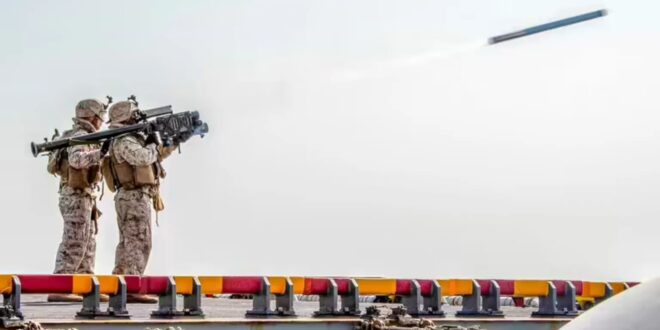Knocking ‘Em Out of the Sky Since ’78
I don’t usually like to start my pieces with a video, but I’ll make an exception in this case. The video below is too awesome not to include right away. It shows a Stinger missile doing what Stingers do best; blowing stuff out of the sky. In this instance, a Russian helicopter (which looks to me like a Mi-28 Havoc) was downed over the Ukrainian countryside last March. It had what you call a “good effect on target.”
A Stinger surface-to-air missile takes down what looks to be a Mi-28 Russian helicopter over Ukraine. Video courtesy of YouTube and Mematiane
To date, we have supplied the Ukrainian military with more than fourteen hundred FIM-92 Stinger anti-aircraft missiles. But, before they got them from us, the Baltic states had been providing the Ukrainians with Stingers since January. To do that, they needed to get US permission which we granted, being pretty sure a Russian invasion was imminent.
As far as weapons systems go, the Stinger is kind of old. It was first designed in 1967 and went into production starting in 1978. Of course, that’s the same year Animal House made its way into theaters, so, yeah, it’s been around for a while. As a matter of fact, it’s been around for so long that the US Department of Defense (DoD) hasn’t bought one from its manufacturer, Raytheon, in 18 years.
They have not been manufactured for so long that some components are no longer commercially available. Raytheon CEO Greg Hayes has a solution to that problem; he says, “…we’re going to have to go out and redesign some of the electronics in the missile of the seeker head.” Hayes continued, “That’s going to take us a little bit of time.”
Raytheon says they hope to increase Stinger production as much as they can this year, but realistically it will take until 2023 or 2024 to rebuild our stockpiles.
The Particulars
The FIM-92 Stinger is a man-portable surface-to-air missile designed by General Dynamics and built by Raytheon Missile Systems. They weigh 35.5 lbs and are about 5 feet long with a diameter of two and three-quarter inches. They fire a 1 kg high explosive (HTA-3) warhead that is launched by a solid fuel rocket motor. It is a “fire and forget” weapon that uses infrared homing to find its target and will hit nearly anything flying below 11,000 feet. Its range is approximately 8 kilometers.
A Stinger missile includes guidance, tail, propulsion, and warhead systems. The tail consists of four folding fins that provide roll and stability control during flight. The guidance system includes a seeker assembly, a guidance assembly, a control assembly, a battery, and four wings that control in-flight maneuverability. The warhead is encased in pyrophoric titanium. The propulsion section included a launch motor and a dual thrust flight motor.
To fire the weapon, aim it at your target. As soon as the seeker locks on, it makes a distinctive sound. Now you can pull the trigger. When you do that, two things happen.
A small launch rocket shoots the missile out of the launch tube and clear of the person firing the weapon.
The launch engine falls away, and the main solid rocket engine lights. This will propel the missile to approximately 1,500 mph, that’s right, Mach 2.The missile is now on its own and will fly to the target with a warhead that tracks to the target using ultraviolet and infrared, where it will explode with devastating effect.
Recently the US Army awarded more than $624 million in a contract to Raytheon to restore US stocks of Stinger missiles sent to Ukraine. It is believed that the current number of missiles sent so far, represents about 25% of those held by the Army. Raytheon has stated it may take up to two years to replace these missiles as they have been out of production since 2015 and many of the components in its complex supply chain are no longer made, in particular its warhead seeker which needs upgrading and redesigned.
The success of the Stinger, Javelin, and other older weapons systems the US considers obsolete may hold a lesson for the US military. That while we should always be willing to expend treasure for better weapons to save blood on a potential battlefield, many of our older systems seem to have retained considerable potency in actual use. While we are reluctant to transfer our newest weapons tech to our allies(for good reasons), they might still find our older systems can be very useful. The US could make for itself a tidy sum in selling, maintaining, and replacing these older systems for our friends and allies while we retain the qualitative edge in warfare with new gear, weapons and sensors.
 Eurasia Press & News
Eurasia Press & News



